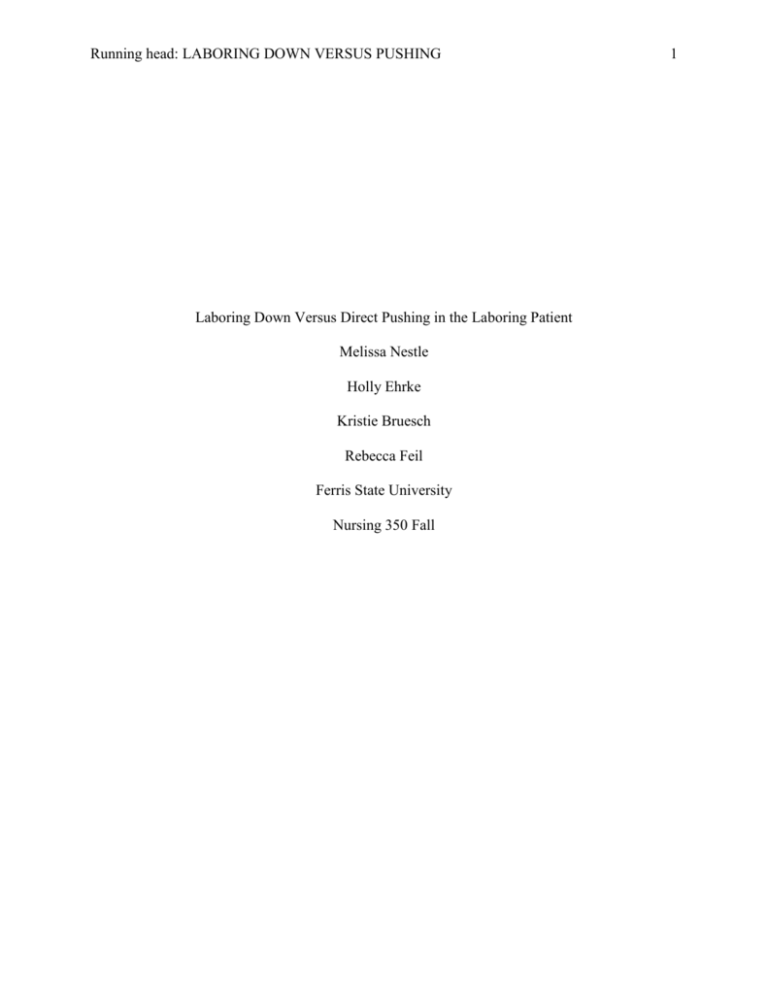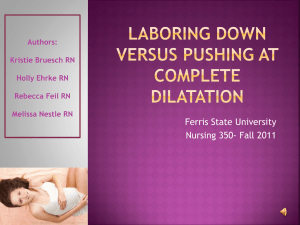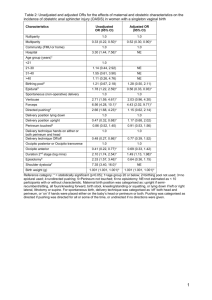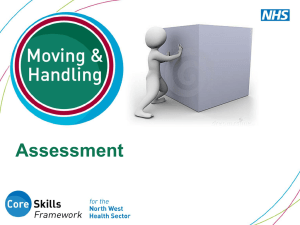File - Kristie L. Bruesch Ferris State University RN to BSN
advertisement

Running head: LABORING DOWN VERSUS PUSHING Laboring Down Versus Direct Pushing in the Laboring Patient Melissa Nestle Holly Ehrke Kristie Bruesch Rebecca Feil Ferris State University Nursing 350 Fall 1 LABORING DOWN VERSUS PUSHING 2 Laboring Down Versus Direct Pushing in the Laboring Patient The aim of this study was to evaluate the benefits of letting women labor down in the second stage of labor. The natural physiological process of allowing the fetus to passively descend into the pelvis shows evidence of improved neonatal and maternal outcomes. The problem, intervention, comparison group and outcomes (PICO) question is, “in the second stage of labor, what is the effect of laboring down after complete cervical dilation on a mother and baby compared with pushing before the cervical dilation is complete?” Does laboring down in the second stage of labor decrease pushing time and maternal fatigue? Does letting a patient labor down increase the likelihood of a normal spontaneous vaginal delivery (NSVD)? Does laboring down decrease the incidence of instrumental deliveries and perineum tears? Hanson (2009) states, “The presence of the nurse at the bedside provides an opportunity to identify the physiological onset of the second stage of labor and determine when the patient feels the Ferguson reflex (unbearable urge to push)” (p. 31). Allowing the patient to labor down in the second stage of labor decreases the length of time a patient spends pushing. Studies show a decrease in perineum lacerations due to the patient spending less time pushing and allowing the perineum tissue to slowly stretch. Allowing a patient to labor down will demonstrate decreased maternal fatigue, decrease pushing time, decreased incidence of instrumental deliveries and incidence of vaginal tears. Delayed pushing causes less fetal oxygen de-saturation and more reassuring fetal heart tones. Method of Search Strategies. LABORING DOWN VERSUS PUSHING 3 The articles for review were selected using Ferris States University library and internet searches. Some members of the group attended a webinar by Ali Konieczny, Health Sciences Librarian, on how to conduct a database search. Databases such as, PubMed, CINAHL, and MEDLINE were used for the search. Burns and Grove state (2011), “The most relevant nursing online database is CINAHL, which contains citations of nursing literature, published commonly starting in the 1980s, but some versions may have information back to the 1930s” (p. 211). Articles Chosen for Review. Ten articles were chosen for the literature review. The articles were chosen on the relationship to the PICO question: “In the second stage of labor, what is the effect of laboring down after complete cervical dilation on mother and baby compared with pushing before cervical dilatation is complete?” The articles chosen were based upon keywords as related to the research topic. Complex searches were further used to narrow the search for articles. Group members conducted searches and submitted the articles for review by the group. Criteria for Inclusion/Exclusion. A literature review consists of examining the quality of the subject and sources. “The review provides a basis for the study purpose and often is organized according to the variables in the purpose statement” (Burns & Grove, 2011, p. 194). The sources of the review must by relevant and current. Burns and Grove (2011) continue to state, “A current source is one published within 5 years of the date accepted for publication” (p. 194). A review of the references was also done to verify the significance of the sources. An evaluation of the articles was done to determine their relevance as related to the PICO question. Each article was examined to determine sample size and design. The following statements were quoted from Burns and Grove, 2011: LABORING DOWN VERSUS PUSHING 4 “If the study was designed to make comparisons and significant differences were found, the sample size, or number of subjects participating in the study, was adequate” (p. 308). “In quantitative research, the sample size must be large enough to identify relationships among variables or to determine differences between groups. However, qualitative research focuses on the quality of information obtained from the person, situation, or event sampled, rather than on the size of the sample” (p.317). “The purpose of design is to maximize the possibility of obtaining valid answers to research questions or hypotheses” (p. 286). “Validity is important because studies must be well designed to contribute strong research evidence for practice. Designs that provide evidence that nursing interventions are effective in achieving desired outcomes are particularly important” (Burns & Grove, 2011, p.253). Articles Chosen for Analysis Application to PICO. The articles chosen for the analysis related to the PICO question: “In the second stage of labor, what is the effect of laboring down after complete cervical dilation on mother and baby compared with pushing before cervical dilatation is complete?” The population that was examined included laboring mothers in the second stage of labor. Comparison of immediate pushing versus passive decent followed by the urge to push were examined and outcomes of evidence-based practiced recommended. Hierarchy of Evidence. The articles were reviewed for their level of hierarchy. Hierarchy of evidence indicates the rank of authority in types of research. The lower the level of the hierarchy of evidence, the LABORING DOWN VERSUS PUSHING 5 higher the level of authority an article or type of research has. The articles chosen for analysis were level I and level II; indicating a high level of authority. Hanson (2009) and Kelly, Johnson, Massey, Purser, Ring, Sanderson, Styles & Wood (2010) present level II evidence, while Brantaco, Church & Stone (2008), Roberts, Torvaldsen, Cameron & Olive (2004) and Simpson & James (2005) present level I evidence related to the second stage of labor and laboring down. Recommendations and Findings. Allowing a patient to labor down during the second stage of labor has benefits for both mother and baby. Randomized clinical studies indicate that the length of time spent pushing in patients that are allowed to achieve passive decent are less than those that demonstrate immediate pushing. In fact, Kelly et al., 2010 states that women that labored down and delayed pushing for up to 90 minutes had “almost 50% reduction in the length of time mothers spent in pushing” as compared to women that started immediate pushing at complete cervical dilatation. Brancato et al., 2008 also found similar results with passive decent decreasing the length of time in pushing with women that had epidurals. When pushing times are decreased, patients have decreased fatigue and improved perineum outcomes. Hanson (2009) states, “Women that respond to physiologic responses to bearing down had a shortened second-stage of labor and improved perineal outcomes.” In Hanson’s (2009) findings, patients that performed immediate pushing experienced increased bladder and perineum problems. Kelly et al., 2010, states similar results to Hanson’s randomized clinical trial in 2002; indicating that delayed pushing decreases maternal fatigue. Roberts et al., 2004, also found comparable results with patients that received epidural analgesia; “Nulliparous women with passive decent were less likely to be fatigued than those using immediate pushing once complete cervical dilatation was achieved.” Improved perineum outcomes relates to the LABORING DOWN VERSUS PUSHING 6 decrease use of instrumental-assisted deliveries. Brancato et al., (2008) states, “Passive decent increases a woman’s chance of having a spontaneous vaginal delivery, decreases risk of having an instrument-assisted delivery, and decreases pushing time.” Immediate pushing at complete cervical dilatation causes fetal compromise. Hanson (2009), states that when patients used Valsalva’s maneuver fetal compromise was detected. Simpson and James (2005) state fetal compromise is evident in patients that perform immediate pushing upon complete cervical dilatation. Results from a randomized clinical trial state, “Results for this study suggest that delaying second-stage pushing until the urge to push and pushing with the open-glottis technique in nulliparous women with epidural anesthesia is more favorable for physiologic fetal well-being…” (Simpson & James, 2005). These results are consistent with Fraser et al., (2000) stating immediate pushing group has decreased fetal oxygen de-saturation, more variable fetal heat tone decelerations, and an increase of the length of active pushing. Increased length of pushing has been attributed to fetal hypoxemia. The American College of Obstetricians and Gynecologists and the American Academy of Pediatrics (2003) state electronic fetal monitoring (EFM) has its limitations. “When the FHR (fetal heart rate) is reassuring, there is a very high probability (>99.9%) that the fetus is doing well and is adequately oxygenated; however, EFM has shown poor specificity in detecting fetal compromise.” (Simpson & James, 2005). Recommendations in the second stage of labor can improve both maternal and fetal outcomes. Hanson (2009) states, “evidence-based care help achieve the improved outcomes documented from women’s spontaneous bearing-down efforts during the second stage”. Passive decent with waiting for the urge to push by the mother can influence both maternal and fetal outcomes. LABORING DOWN VERSUS PUSHING 7 Analysis of Shortcomings. Shortcomings within the articles were reflective upon variables and subjects. For example, in Kelly’s (2010) RCT study, the scale used to detect maternal fatigue was not “sensitive enough to detect different levels of maternal fatigue.” Also in Kelly’s et al., (2010) study only examined nulliparous mothers and due to financial constraints limited fetal outcomes were measured. In Brancato’s et al., (2008) studies the sample sizes were small and the method of pushing was not consistent. Also, “Epidural protocols were not discussed in the study and could have affected the results” (Brancato et al., (2008). In Simpson and James’ (2005) studies, the analysis was limited to nulliparous women that received an epidural. The study was also was limited to healthy nulliparous women. Summary of EBNP Recommendations Setting, patient/population, interventions. All article studies where done with full term mother’s in a hospital setting. Evidencebased nursing practice (EBP) has the benefit to improve outcomes for patients, providers and healthcare agencies (Burns & Grove, 2011, p. 468). The study conducted by Kelly et al., 2010, concluded that delaying pushing for up to 90 minutes or until the mother felt the urge to push decreased the length of time mothers spent pushing (p. 85). Pushing expends a large amount of energy which increases fatigue. Limiting this with laboring mothers will enhance the amount of energy they can spend on pushing when extra energy is needed. The study written by Hanson (2008), brought out the importance of communication strategies as a way of supporting women’s spontaneous pushing efforts. As women move into the second stage of labor, nurses can help women by giving them direction in a supportive manor. “High verbal praise and a reflection to the woman that the nurse or midwife is present and aware of each contraction and her response” LABORING DOWN VERSUS PUSHING 8 was significantly important (Hanson, 2008, p. 34). Praise with gentle direction tends to enhance the motivation of women in labor giving them more control which increases self-esteem and selfsatisfaction. The study written by Brancato, Church and Stone (2008) states delayed pushing promoted safe and effective spontaneous vaginal births with a decrease use of instruments and decreasing the pushing time (p. 11). When using instruments to assist with deliveries, adverse conditions can occur. Natural, safe deliveries are encouraged with minimal use of instruments to assist with the delivery is recommended. Effects on the baby are just as important. The study written by Simpson and James (2005), stressed the importance of delayed pushing related to fetal oxygen saturation. During the second stage of labor, particularly when pushing is taking place, fetal oxygenation is affected. It was found that with delayed pushing, the active pushing phase was shortened which decreased the oxygen de-saturation effect and fetal heart rate effects on the infant. When decreased saturation occurs, the brain is deprived from oxygen which could have an adverse affects on the infants brain function if sustained for a long period of time. These effects could be effects the child would have to deal with their entire life. Impact upon Nursing Practice. From these articles, we can conclude that delayed laboring down has positive outcomes on both mother and baby. For the mother, it decreases fatigue and utilizes energy when needing to push, avoids adverse outcomes of sustained strenuous pushing, and improves the birthing experience. For infants, the effects decrease fetal distress of effects on fetal heart rate and oxygenation. Nurses need to be aware of the positive effects on mother and baby with delayed pushing. Being aware of the effects of delayed pushing on the mother and baby and implementing interventions to assist mothers with delaying pushing will promote the wellness LABORING DOWN VERSUS PUSHING 9 and safety of mom and baby. Utilizing studies to change nursing practice to promote improved experiences promotes health and wellness. Recommended Changes in Nursing Practice Based on the summary of outcomes a change in nursing practice is recommended. The most significant finding that was consistent in all of the studies was a decrease in the amount of time a patient spent pushing. If permitted to labor down, a patients’ pushing time was decreased, the patient was less likely to be exhausted and was more over all satisfied with her labor experience. “Significant positive effects were found indicating that passive descent should be used during birth to safely and effectively increase spontaneous vaginal births, decrease instrument-assisted deliveries, and shorten pushing time.” (Brancato et al., 2008,p. 4.) Laboring down allows the fetus to descend naturally causing a slow stretching of the perineum tissues without increasing stress on the fetus. This is correlated with a decrease in perineum lacerations. “There is a normal deterioration in fetal acid-base status over the course of the second stage and an inverse relationship between length of second stage and umbilical cord blood pH” (Simpson & James, 2005, p. 150). There is minimal research on this subject and it warrants future studies. Most of the studies regarding laboring down were maternal-based. There have been studies stating that immediate pushing stresses the fetus and increase the risk of metabolic acidosis and other studies that state it has no effect. “Significant maternal morbidity, such a perineum damage, fecal incontinence, anal sphincter injury, and pudendal nerve damage have been correlated with immediate pushing.” (Brancato et al., 2008, p. 9). This can have a significant impact on a patient’s emotional state due to embarrassment related to possible public incontinence issues. Scar tissue may decrease sensation or possibly cause pain during intercourse. “Current research indicates that immediate LABORING DOWN VERSUS PUSHING 10 pushing can increase birth complications, whereas passive descent can prevent birth complications.” (Brancato et al., 2008, p. 11). It was once thought that a woman is at an increased risk for post-partum hemorrhage if she had a prolonged second stage of labor. Literature has not been found regarding impact of laboring down and post-partum hemorrhage. There has been minimal research on the effects of maternal exhaustion related to immediate pushing and its impact on breastfeeding. Increased risk of cesarean section related to immediate pushing is another subject that warrants future research. There are many areas that could be examined and utilized to show additional benefits to laboring down. Open glottis pushing in addition to laboring down is the current recommendation. The more interventions a patient has, the greater the risk for additional complications. Reference LABORING DOWN VERSUS PUSHING 11 American Psychological Association. (2009). Publication Manual of the American Psychological Association. (6th Ed., 2nd print). Washington, DC: Author. ISBN 10:14338-0561-8 Brancato, R. M., Church, S., & Stone, P. W. (2008). A meta-analysis of passive descent versus immediate pushing in nulliparous women with epidural analgesia in the second stage of labor. Journal of Obstetric, Gynecologic, & Neonatal Nursing, 37(1), 4-12. doi: 10.1111/J.1552-6909.2007.00205.x Burns, N., & Grove, S. (2011). Understanding Nursing Research. Maryland Heights: Elsevier Saunders. Hanson, L. (2009, January-March). Second-stage labor care Challenges in spontaneous bearing down. Journal of Perinatal & Neonatal Nursing, 23(1), 31-39. Kelly, M., Johnson, E., Lee, V., Massey, L., Purser, D., Ring, K.., Sanderson, S., Styles, W. & Wood, D. (2010, March). Delayed versus immediate Pushing in second stage of labor. The American Journal of Maternal/Child Nursing, 35(2), 81-88. Simpson, K. R., & James, D. C. (2005, May-June). Effects of immediate versus delayed pushing during second-stage labor on fetal well-being. Nursing Research, 54(3), 149-157. Roberts, C. L., Torvaldsen, S., Cameron, C. A., & Olive, E. (2004, December). Delayed versus early pushing in women with epidural analgesia: a systematic review and meta-analysis. An International Journal of Obstetrics and Gynaecology, 111, 1333-1340. doi:10.1111/j.1471-0528.2004.00282.x LABORING DOWN VERSUS PUSHING 12








